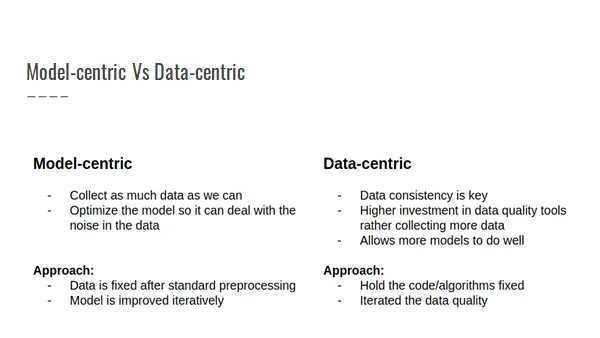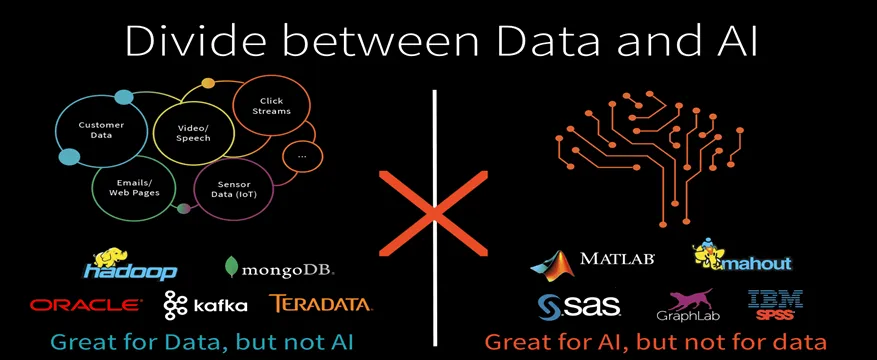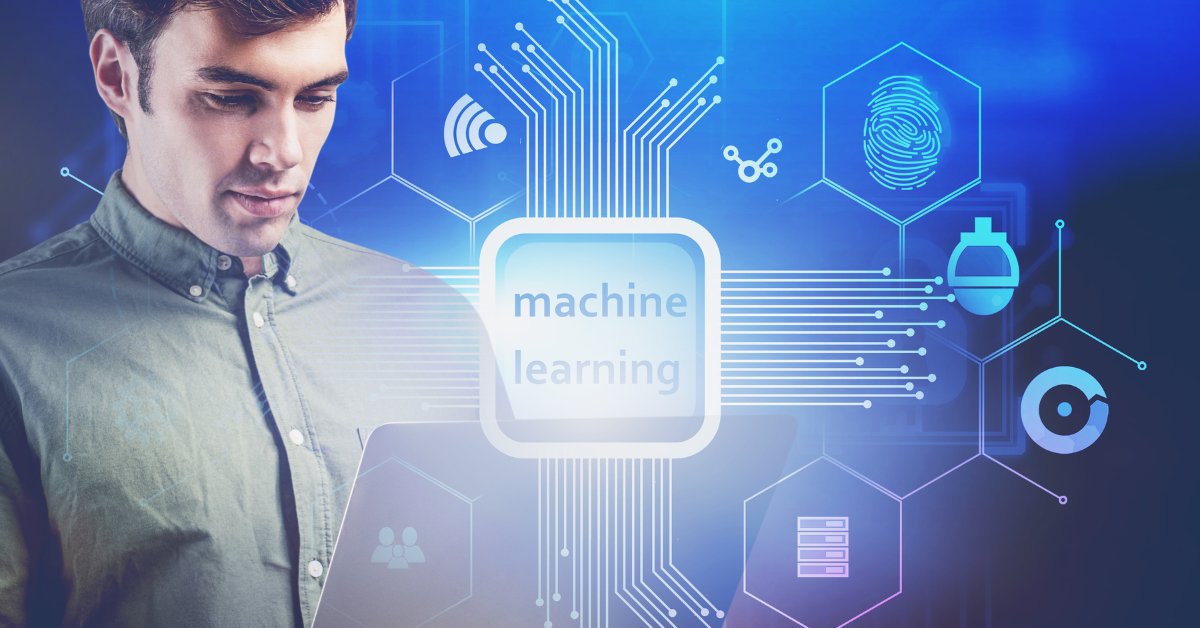Moving from Model-centric to Data-centric approach
- Model-centric and Data-centric Google researchers found that “data cascades compounding events causing negative, downstream effects from data issues triggered by conventional AI/ML practices.
- That undervalue data quality are pervasive (92% prevalence), invisible, delayed, but often avoidable.
- Lets discuss on the trend being followed widely for most or all of the AI use cases across the organizations.
- Data-centric are just to make myself clear the term AI over here in being referred as an umbrella encompassing our Data Science/ML and Deep Learning Use cases.
AI System for Data-centric
- The Model and Data-centric of all AI systems , both go hand in hand in producing desired results.
- We do realize that the AI community has been biased towards.
- putting more effort in the model building One plausible reason is that AI industry closely follows academic research in AI.
- Owing to open source culture in AI , most cutting edge advances.
- In the field are readily available to almost everyone with who can use git hub but working on.
- Data is sometimes thought of as a low skill task and many engineers prefer to work on models instead.
- But the equation suggests in order to improve a solution we can either improve our code or, improve our data or, of course, do both.

Model Approach for Data-centric
- ML is an iterative process this involves designing empirical tests around the model to improve the performance.
- Data-centric consists of finding the right model architecture and training.
- Procedure among a huge space of possibilities to arrive to a better solution.
Approach to AI in Data-centric
- In the dominant model-centric approach to AI, according to Ng.
- Collect all the data you can collect and develop a model good enough to deal with the noise in the data.
- The established process calls for holding the data fixed and iteratively improving the model until the desired results are achieved.
Data approach for Model and Data-centric
- This consists of systematically changing/enhancing the datasets to improve the accuracy of your AI system. This is usually overlooked and data collection is treated as a one-off task.
- In the nascent data-centric approach to AI, “consistency of data is paramount,”. To get the right results, you hold the model or code fixed and iteratively improve the quality of the data.

Who is talking about Data-centric?
- Research scientist Martin Zinkevich emphasizes implementing reliable.
- Data pipelines and infrastructure for all business metrics and telemetry before training your first model.
- He also advocates testing pipelines on a simple model or heuristic. To ensure that data is flowing as expected prior to any production deployment.
- The Tensorflow Extended (TFX) team at Google has cited Zinkevich and echoes. That the building real world ML applications “necessitates some mental model shifts (or perhaps augmentations).
How to improve the centric?
- Recently, however, more attention has been paid to the role of low-quality data is playing in what Ng has identified as the proof-of-concept to production gap, or the inability .
- AI projects and machine learning models to succeed when they are deployed in the real world
- he message from both of these leaders is that deploying successful ML applications requires a shift in focus.
- Instead of asking, What data do I need to train a useful model? What data do I need to measure and maintain the success of my ML application.
Data and AI Divide

- Popular machine learning frameworks such as TensorFlow, PyTorch, and SciKit-Learn don’t do data processing.
- Because these data systems don’t “do AI” and these AI technologies don’t “do data”, it’s extremely hard for enterprises to succeed with AI, which after all requires both ingredients to be successful.
- Data science tools that emerged from a model-centric approach offer advanced model management features in software that is separated from critical data pipelines and production environments.
- This disjointed architecture relies on other services to handle the most critical component of the infrastructure data.
- As a result, access control, testing and documentation for the entire flow data spread across multiple platforms.
Need for ML Platform in Data-centrics
- At this point before proceeding further I would reiterate More data is always not equivalent to better data. A data-centric ML platform brings models and features alongside data for business metrics, monitoring and compliance. It unifies them, and in doing so, is fundamentally simpler.
- Data is often siloed in various business applications and is hard and/or slow to access.
- Likewise, organizations can no longer afford to wait for data to loaded into data stores like a data warehouse with predefined schema.
- On the one hand, data in aggregate becomes more valuable over time as you collect more of it.
- The aggregate data provides the ability to look back in time and see the complete history of an aspect of your business and to discover trends.
- In contrast, a newly created or arriving data event gives you the opportunity to make decisions in the moment that can positively affect your ability to reduce risk, better service your customers, or lower your operating costs.
Capex and Opex for Moving
- From the infrastructure invested to have data collected, to the number of human resources dedicated to it and how rare to have it collected in the ideal situation.
- The industry trend is to move away from large capital expenditures (capex) to pay for network and server capacity in advance and toward a “just-in-time” and “pay-for-what-you-use” operating expense approach.
- Improving how your entire organization interacts with data. Data must be easily discoverable with default access to users based on their role(s).
- Prioritize use cases that make use of similar or adjacent data.
- If your engineering teams need to perform work to make data available for one use case.
- Then look for opportunities to have the engineers do incremental work in order to surface data for adjacent use cases.
ML Ops (machine learning operations)
- It is the active management of a productionized model and its task, including its stability and effectiveness.
- In other words, ML Ops is primarily concerned with maintaining the function of the ML application through better data, model and developer operations.
- And prepare labelled datasets for model building while enabling data scientists to explore and visualize data and build models collaboratively.
- Simply put, ML Ops = Model Ops + Data Ops + Dev Ops.
- Not-define Analytics worlds of data science and engineering together with a common platform making it easier for data engineers to build data pipelines across siloed systems.
- Unified Analytics provides one engine to prepare high quality data at massive scale and iteratively train machine learning models on the same data.
- Not Analytics also provides collaboration capabilities for data scientists and data engineers to work effectively across the entire AI lifecycle.
Approaches
- So now that we have defined the problems/ distinguished between the two approaches why need for a Data centric platform.
- Let’s look into the capabilities required to support any organizations transition to a Data Centric Approach.
- I am not here to advocate usage of a particular product or tool but rather hand hold on general capabilities to look out for before you decide.
- On a build vs buy decision and also no hard written fact everybody may have their own trajectory quite different from another.
Data processing and management
- The bulk of innovation in ML happens in open source, support for structured and unstructured data types with open formats and APIs is a prerequisite.
- The system must also process and manage pipelines for KPIs, model training/inference, target drift, testing and logging.
- Not all pipelines process data in the same way or with the same SLA.
- Depending on the use case, a training pipeline may require GPUs, a monitoring pipeline may require streaming and an inference pipeline may require low latency online serving.
Secure Collaboration
- Real-world ML engineering is a cross-functional effort thorough project management and ongoing collaboration between the data team and business stakeholders are critical to success.
- Access controls play a large role here, allowing the right groups to work together in the same place on data, code, and models while limiting the risk of human error or misconduct.
Testing
- Ideally automated, tests reduce the likelihood of human error and aid in compliance.
- Data tested for the presence of sensitive PII or HIPAA data and training/serving skew, as well as validation thresholds for feature and target drift.
- Models should tested for baseline accuracy across demographic and geographic segments, feature importance, bias, input schema conflicts, and computational efficiency.
Monitoring
- Regular surveillance of the system helps identify and respond to events that pose a risk to its stability and effectiveness.
- How soon discovered when a key pipeline fails, a model becomes stale or a new release causes a memory leak in production?
- When the last time all input feature tables refreshed or someone tried to access restricted data?.
Reproducibility
- We know AI modes are nondeterministic so it is important to validate the output of a model by recreating its definition (code), inputs (data), and system environment (dependencies).
- If a new model shows unexpectedly poor performance or contains a bias towards a segment of the population, organizations.
- Need to be able to audit the code and data used for feature engineering and training, reproduce an alternate version, and redeploy.
Documentation
- Documenting an ML application scales operational knowledge, lowers the risk of technical debt, and acts as a bulwark against compliance violations .
- Document is an important feature that brings human judgement and feedback to an AI system.


